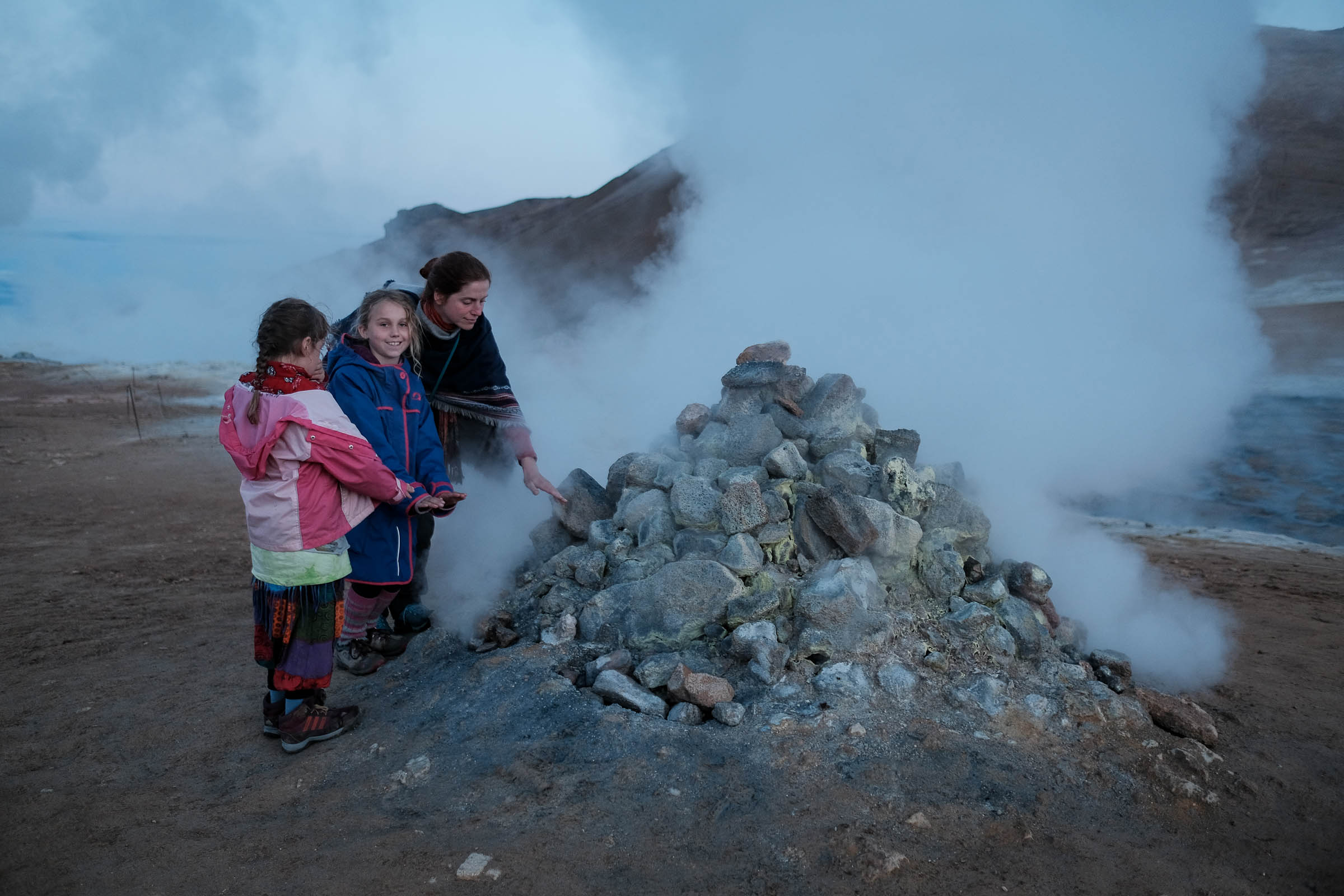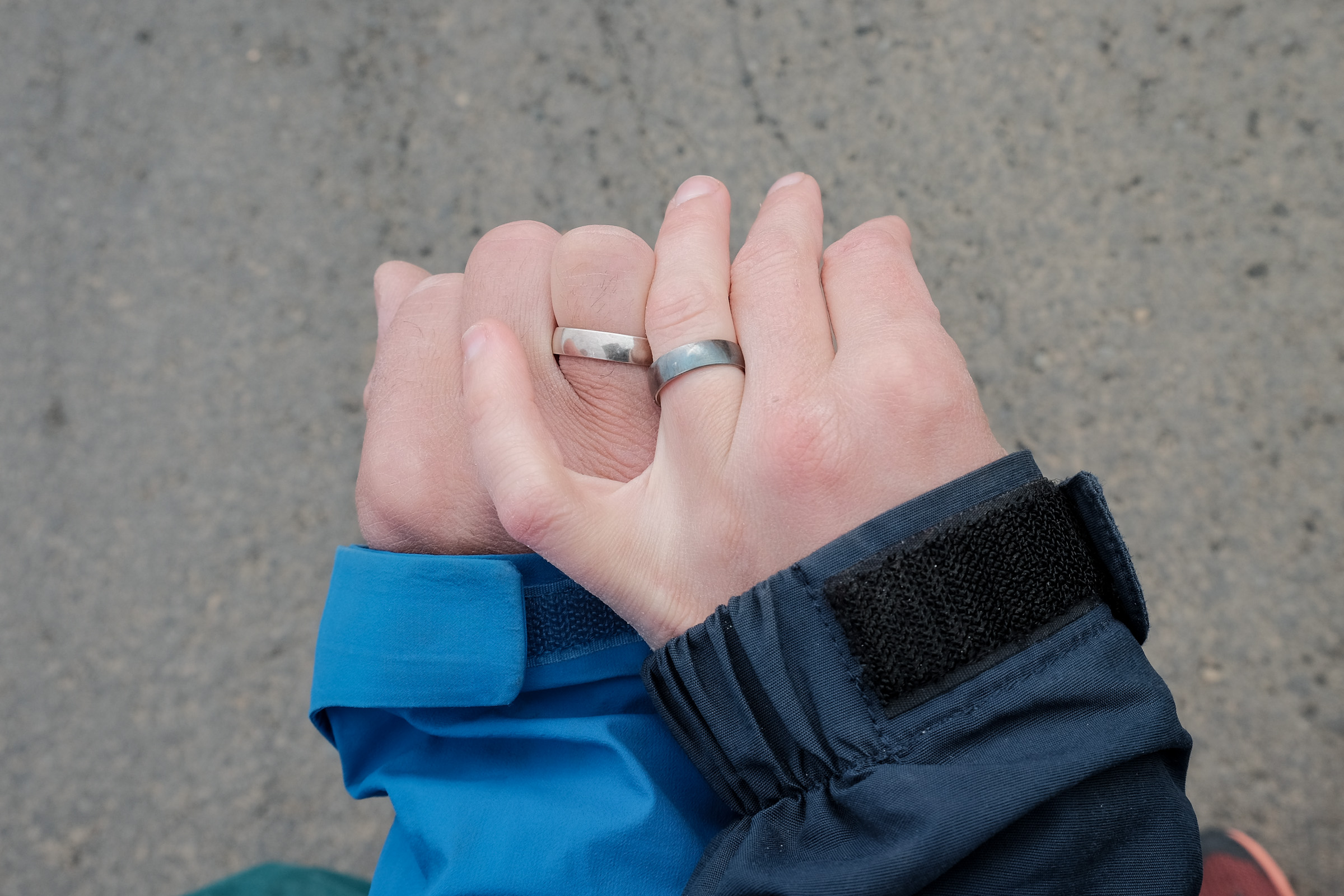Finally summer vacation! After our exciting “homemade“ wedding, work re-entry after the parental leave with Merida and Nora’s primary school graduation ceremony, we plunged into adventure with the Defender “Gertrud“! On the way to the north we saddled on the ferry in Denmark: below deck reigns Jugendherbergsfeeling and on deck one hears supposedly the wind “We love the storms, the roaring waves...
We licked blood on the Faroe Islands, because the little glimpse we got in just under three days on the stopover of the ferry from Denmark to Iceland was enough to fall in love with the rough islands without a rescue! We have retained memories of wind, green mountains, grassy, decaying wooden houses, narrow, unlit, underwater tunnels and the desire for more: coming back, hiking, discovering all the islands!
We were lucky: Due to the strong winds and accordingly lively sea we took part in the first coastal boat trip for two weeks and are of the opinion, the captain understands his craft! We are deeply impressed how close he steered the boat to the rocks and into the gorges to show his guests the island of Streymoy from outside. We had plenty of time to observe seabirds. In the past, the parrot hunters were caught and used as food by intrepid men who were roped over the rock. Today, fortunately, they are only caught for monitoring purposes, ringed and released. On the grassy parts of the cliffs, the summer graze over sheep, which are still brought back to the heart of the island in the spring and autumn by means of cable actions - over 600 meters deep, steep cliffs. This could explain the price for Faroese knitted goods: A few thick knitted gloves cost in the shop of the tourist information approx. 90€!
Iceland, we’re coming! In bright sunshine we are welcomed in Seyðisfjörður and are pleased about the rainbow road in the village and Gufufoss, our first Icelandic waterfall.
We wanted to take it slow and recover from the previous hardships a bit in Iceland’s oldest national forest Hallormsstaður at the glacier lake Lagarfljót. According to legend, here lives a terrible, 12 m long, poisonous sea snake, which has already been sighted on land! Here we met Runa, who had experienced Germany as an au pair many years ago. She explained to us that many Icelanders from the south are on holiday here in the northeast in order to avoid the ongoing rain weather: the weather forecast is very reliable, at least they almost always vote for bad weather. For a long time we remembered the bright sunshine that we should miss more or less until the end of our journey.
Aerial photos already have something for themselves and are easily feasible with a drone nowadays. However, it is important to keep in mind the local circumstances. Our drone often struggled with the wind and we had the unpleasant experience of what warnings about electromagnetic interference can mean: The drone is gone! Fortunately, Alexander was able to find her after two hours. In time, the rest of the family discovered the typical triangular highlands cloister and helped out a group of Czechs whose fuel was running out. Thank you, there was a strong sip of Sliwowitz.
After the short-hosen weather at the lake we now unpacked the winter clothes and set off for the Askja volcano, which has two craters: a very large and a small side crater with water in bath temperature. Of course we girls had to test it! Down into the crater was no problem, but the ascent was less fun, it had started to rain and the steep walls had turned into slippery mud, so it was still quite exciting. Once again, we had no desire to look at the main crater.
In addition to hiking, the Dreki Camp is also a place where you can watch snow pumice or throw pumice stones into the creek, which then swim happily on the surface.
To the south of the Askia volcano, you drive through terrain where NASA had its astronauts train for moon landing, and here, too, lies the Holuhraun lava area, Iceland’s most recent lava field from 2014. Our oldest two were quite impressed by the fact that the stones on which they go are younger than themselves! Not far from here we explored a beautiful waterfall. All alone (we didn’t think about that at the time, but when we sometimes had to do waterfalls in the south three weeks later, we only became aware of this special favour).
Herðubreið, the queen of the mountains is so impressive and not to be overlooked from many points of view, so that she accompanied us for several days.
A stopover bird on the Landy roof is a fine thing, especially in mild temperatures and a fantastic sunset (and sleeping children, as it is already far after midnight). So after our trip to the highlands we had also thought about the rest of the trip – a small preview: In the following weeks there was no sunset in mild and dry car roof weather, we even brought beer home again – and that with the limited amount of alcohol imported (because of our stay in the Faroe Islands only 2 litres per adult were valid).
Here, too, the surrounding area invites you to hike – but we were a little surprised that none of the staff at the café at the farm knew anything about hiking routes, but that probably has to do with the fact that many young people work on Iceland seasonally and don’t necessarily know the possibilities of the surrounding area. But also without a plan and map we found a piece of way through the Heiði, as here is called the treeless tundra landscape, on which we came close to the many birds such as golden rain plover, rain-breeding bird or shore-snip. Also a river had to be crossed and thus everyone got their money’s worth!
The special thing about this place is not even the playground, but the two polar fox puppies that grow up here. Hopefully, the brothers survived the summer, because the stream that winds through the meadow is treacherous: a puppy was rescued from drowning by Alexander.
On the road at Landsendi
Unser Lotter-Lager-Leben
Almost close to the touch one comes to the many droll puffins on the small peninsula Hafnarhólmi near Bakkagerði. You can watch them here for hours on their arrivals and departures. Frozen limbs become warm again with hot chocolate in the Álfakaffi (Elfencafé, as there is an Elfenburg next door). The café belongs to a fish factory, which can be visited and where we covered ourselves quite cheaply with dried haddock and fresh cod.
In Żórshöfn the bad weather drove us to the restaurant at the harbour for breakfast, although no classic breakfast is served here and unfortunately also no pancakes, as you can often read elsewhere, but we are flexible and so we did also Icelandic Skyr-Torte with Fish & Chips. Mainly warm and dry! We set out on an adventure with a lot of strength: in the rain and wind we drove out onto the peninsula of Langanes to visit the largest sub-column colony in Iceland. Unfortunately it was far too uncomfortable to really observe the birds, but without a few photos (also of trottellummen, parrot divers and other water wings) we could not drive back of course!
The Ásbyrgi gorge looks from above as if Odin’s god-rose Sleipnir had left his footprint in the rock. This is at least the mythological explanation of this place, which is also declared the Elven capital. The geological cause of the strange rock formation lies in three glacier courses a few thousand years ago – i.e. catastrophic volcanic eruptions under glacial ice, in which huge amounts of ice suddenly melt and the resulting flood develops an immense destructive force through co-grill. The former riverbed of the Jökulsá á Fjöllum (in whose course, for example, the waterfalls of Dettifoss and Selfoss) was widened, but the river itself later sought another bed further east. From the sole of the gorge, a hiking trail leads up to the edge of the horseshoe print. From here you have a beautiful view into the rock Eyjan, which narrows the entrance to the gorge.
Of course, the many magnificent waterfalls of the island were also something to do with us – but we did not experience so much worth telling afterwards, apart from the fact that it was always worth it for us to use the hours at midnight for visits, since then the light was the most beautiful and the crowd of visitors was the most bearable (with very good luck we were also once alone).
Mývatn means mosquito lake - fortunately for us we notice little of it, but at some times beekeepers are probably the best sellers par excellence. On our nocturnal arrival the shore of our campsite is full of different ducks, so that the children first go on a discovery round. By the time we had slept the next day, all the ducks were out looking for food. However, I must confess that our private highlight of the day were the free hot showers.
In the north of Iceland there are some starting points for whale watching by ship. We had chosen Dalvík because the local shipping company offers trips in the local fjord, so you don’t have to go to the open sea and we speculated that the probability of whale sightings is better here. The blue whale could not be seen on our trip, but at least occasionally a playful humpback whale appeared and the boat trip itself is already a small adventure for our children.
However, it does not only have advantages if you are mainly out of regular opening hours, so these three photos are all we could take from this – according to hearsays really interesting Heringsmuseum in Siglufjördur. A visit will be noted on the travel request list...
The island of Drangey was a tip from our island-experienced friend Marled. The café with a beautiful campsite and cute grass-sodden cottages at the thermal spring Grettislaug is operated by the same family, which also offers boat trips to the island of Drangey. We found here a place to feel good, which invited us to extensive walks on the driftwood beach as well as to watch the coastal schwalben chicks, which were fed directly on the way by their parents.
Our captivated botanist heart beats higher than we discover hundreds of lunar craters on the meadow at the rock break; beautiful but inconspicuous and rare fern plants, of which it was believed in the Middle Ages that the fiddle leaves shone by moonlight. In addition, we enjoy the sight of sand rain plovers, colorful lichens and snow gentian, as well as eating (warm!) fried salmon, marshmallows and have nice conversations with a Slovenian family at the campfire.
In the small, fast boat to Drangey our tour guide explains that he wants to settle the costs only after the trip, because the wind blows today from all directions and he can not guarantee to land Drangey also... Well then, on to the island of Drangey!
Fortunately, the wind subsides and we can enter the island kingdom. Over a steep path, which is secured by ropes, it goes to the highest and at the same time most beautiful part of the island - it lies 180m above sea level... To the right and left of the path are countless parrot divers, tordalks, trottellummen and ice-storm birds. Just before we have earned ourselves a little break with coffee, cocoa and chocolates, there is another approx. 10m high ladder to overcome - no problem for us! After the promised break, our tour guide tells many exciting stories about the island, the outlawed Saga hero Gretti and the life of the parrot hunters.
There are things that you don’t believe. We left the campsite in Hvammstangi for a handful of herrings richer and poorer and a smile: Last night we rescued a young man who was on the road with his girlfriend and rented tent, but without herring, and who was desperate to build up. Don’t go without herrings! It’s nice to be able to help so easily.





